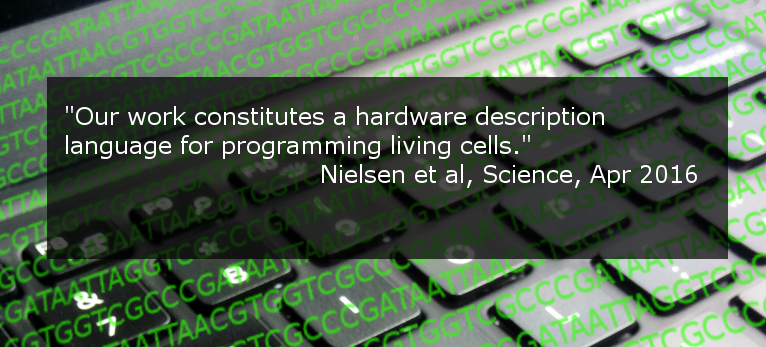… and imagine if you could program life itself. Rather than 0’s and 1’s, you have four possibilities, a computing system performing quaternary arithmetics.
I still remember being dazzled as a freshman in college, during the first computer science lecture. The professor spoke of quantum computers, where improvements in speed of calculations can be measured in squaring time 2n rather than the traditional doubling time (i.e. Moore’s law) 2n. And there was biologic computing, using simple building blocks of genetic material ACTG to perform calculations which take place in living cells.
Then, I spent the 15 years that follows writing them off as science fiction, pontifications of an old man.
I was, of course, wrong.
This month, genetic programming was made possible in a Science paper where MIT researchers created hardware programming language which translates to in vivo biologic circuits with 92% accuracy, previously thought to be highly unreliable and difficult.
I’m no synthetic biology expert (as it turns out, very few people are), so I’m sure I got some of the details wrong. But no matter which way you look at it, programmable cells is a game changer.
The Tipping Point for Electronics
The analogy is akin to creating a CPU. In the very beginning, processing units for a computer were made by hand in vacuum tubes. They were very large, very slow to build, and very fragile. When you put vacuum tubes together, you create logic gates. With logic gates, you can now manipulate more abstract concepts using tools such as AND/OR/NOT/XOR, paving the way to modern circuits.
Now imagine you had to build all these high-level sophisticated gates by hand, and they failed with such high frequency and generating so much heat, you can’t actually rely on the machine to do any real work.
This was solved with the transistor. The transistor was perhaps one of the most important inventions in the 20th century, replacing vacuum tubes with solid-state mechanics which are far smaller.
The key property of the transistor was it ability to be reliably mass-produced. An engineer designed the circuit using logics similar to a programming language, the machine translates it to transistor arrangements in corresponding logic gates and lays down individual transistors on a physical hardware chip.
The Tipping Point for Synthetic Biology?
The folks at MIT created a way to do this with the living cell. The only difference is that instead of transistors, they used DNA sequences. A human could design a genetic circuit using a programming language Verilog. The software then translates these logics into DNA and RNA sequences representative of those AND/OR/NOT/XOR logic gates. With the proper hardware – which MIT has but the regular household thankfully doesn’t – one can then “print” the sequence into a cell and reasonably expect the cell to perform according to the programmed logic.
What are the potentials of this technology? Optimistically, it could solve some of the hardest health care problems in America today. Traditionally, chemotherapy for cancer relies on a scorched earth approach. The treatment is toxic to cancer and the patient, and you’re hoping that the patient will outlast the cancer. New biologic agents such as monoclonal antibiotics (Gleevec, for instance), but they don’t always behave the way you hope they would.
Ultimately, you still have to spend an obscene amount of money designing a tiny molecule that could (1) identify cancer cells, and (2) destroy cancer cells.
So what if instead of using small molecules if you could use a programmable living cell instead? At the very least, you can begin to modularize the key behaviors – the genetic code for “find the lymphoma” and those for “make anti-lymphoma proteins” can be separately developed. Trying new chemotherapeutic agents would then be a matter of installing a “new cancer-detecting app” onto a batch of smart cells.
Excited and a Bit Unsettled
Good research is one that gets your mind thinking about the future. The best research is one that makes you start thinking about the absurd but, in some unsettling way, suggests “well it’s not that far-fetched anymore.”
As with most powerful technology, in the wrong hands, this can be incredibly dangerous. In its future, mature form, wielding the power of creating “designer bacteria” the same way every kid with a laptop can write an iPhone app can have serious implications. And what are the implications when one day we move beyond bacteria to design multi-cellular eukaryotes?
Tomorrow’s Flavor of Apocalypse in Vogue?
Of course, the science fiction fan in me wants to imagine a new world with self-learning, artificially intelligent computers capable of designing their very own mitochondria-powered incarnations.
That makes for yet another exciting scenario of apocalypse in addition to this undead variant, this celestial variant, and this earthly-but-with-bow-and-arrows variant. It would support the science from this hasta la vista variant, although it would also render the need for captive humans in this bullet-dodging variant obsolete.
Implications for Radiology
Cellular level customizability sets molecular imaging abuzz. Anatomic imaging continues to be the mainstay of radiology. However, just as accurate molecular tracers for tumor imaging will give rise to better metastatic disease detection, accurate molecular tracers engineered to tag other engineered cells – arguably making for an easier tracer development – provides a tool to follow the activity of these “smart cells.”




